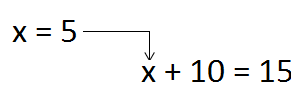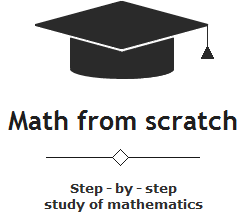An expression is any combination of numbers, letters, and operation characters. We can say that all mathematics consists of expressions.
There are two types of expressions: numeric and alphabetic.
Numeric expressions consist of numbers and signs of mathematical operations. For example, the following expressions are numeric:

Letter expressions contain letters in addition to numbers and operation symbols:

The letters contained in the literal expressions are called variables. Remember this once and for all! Ask any student what a variable is-this question will put him in a stupor, although he can solve complex mathematical problems without knowing what it is. Meanwhile, a variable is a fundamental concept, without understanding which it is impossible to study mathematics.
By the word «study» we mean independent reading of the relevant literature and the ability to understand what is written there. I solve some problems, but I can’t understand what is written in lectures and books. This feeling is familiar to everyone, especially students.
Since the concept of a variable is very important, let’s look at it in more detail. Look carefully at the word «variable». Does this remind you of anything? The word «variable» comes from the words «change», «change your value». A variable in mathematics is always expressed by a letter. For example, write the following expression:
a + 5
This expression. Here is one variable a. since it is a variable, it can change its value at any time. For example, Let’s change the value of this variable. Set it to 5. To do this, write down the variable itself, then put an equal sign and write 5
a = 5
What will happen as a result of this? The value of the variable a, i.e. 5, will be included in the main expression a + 5 and replaced with a.
As a result, we have 5 + 5 = 10.
We have considered the simplest expression. In practice, there are more complex expressions that contain fractions, powers, roots, and parentheses. It looks complicated. In fact, there is nothing complicated about this. The main thing is to understand the principle itself.
In textbooks, the following tasks are often found: find the value of the expression x + 10, for x = 5. Such tasks require that a variable be substituted for its value. Let’s complete this task. The value of the variable x is equal to 5. Substitute this five in the original expression x + 10 and get 5 + 10 = 15.

A variable is a kind of container where the value is stored. Variables are convenient because they allow you to prove theorems without giving examples, and write down various formulas and laws.
Remember the second lesson in the «Basic operation». To understand what addition is, we gave the example 5 + 2 = 7, and said that the numbers 5 and 2 are summands, and the number 7 is the sum. But we could understand this topic without an example if we used a literal expression. We would denote the summands with any letters, for example, a and b, and we would denote the sum as c. Then we would get an expression with three variables a + b = c, and we would say that a and b are summands, c is the sum.
And now, having the expression a + b = c, you can use it by substituting any numbers instead of the variables a and b. And the variable c will get its value automatically, depending on which numbers we substitute for a and b
As a practice, you can complete the following task. The expression a + b = c is given. Find its value if a = 10, b = 6. The c variable will get its value automatically. Write the answer as follows: for a = 10 and b = 6, the variable c is equal to such and such a number.
Decision:
a + b = c
10 + 6 = 16
Answer: for a = 10 and b = 6, the variable c is 16.
Expression value
The phrase «perform an action» means to perform one of the actions. In elementary school textbooks, you can often find tasks that contain the following content: «perform an action», and then give examples that need to be solved. When you encounter a similar problem, you should immediately understand that you are required to solve this example. Solving the example and finding the value of the expression is actually the same.
For example, the expression 10 + 6 is given, and we need to find the value of this expression. This means that we have to solve this example. Put an equal sign = and write the answer:
10 + 6 = 16
The resulting sum of 16 is called the value of the expression 10 + 6.
The value of an expression is the result of performing the actions contained in the expression.
Let’s look at a few more examples.:
- 16 is the value of the expression 4 ├Ś 4, since 4 ├Ś 4 = 16
- 20 is the value of the expression 10 + 10, since 10 + 10 = 20
- 5 is the value of the expression 10 ├Ę 2, since 10 ├Ę 2 = 5.
